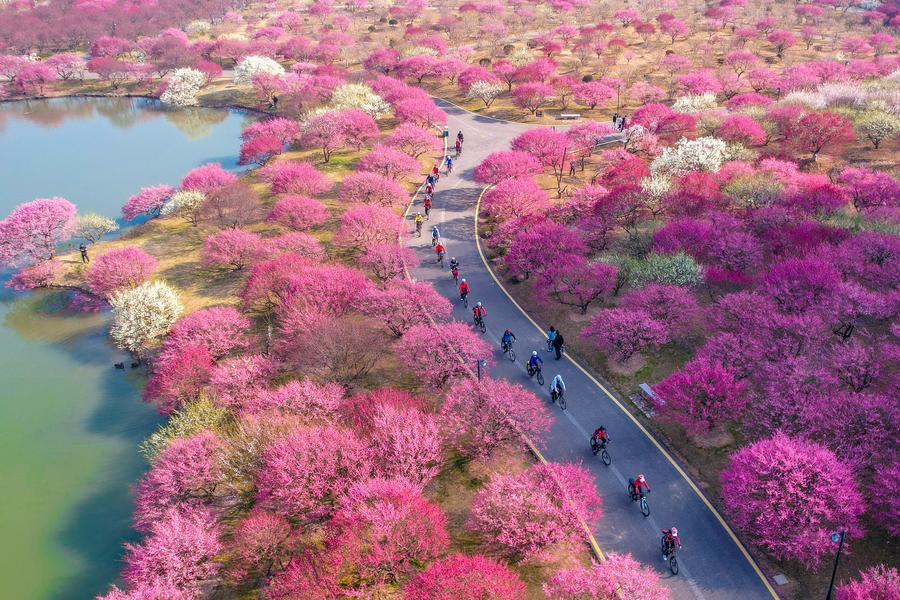Peace and plenty blossom in east China's revolutionary heartland

Over eighty years ago, the rolling hills where Jiangsu, Zhejiang, and Anhui provinces converge echoed with gunfire as New Fourth Army soldiers repelled Japanese invaders. Today, those same landscapes pulse to a new rhythm: the drumbeat of high-quality development.
In the verdant hills of Guangde City, Anhui, stands the solemn grave of martyr Zheng Dafang. In a local battle in March 1944, Zheng, then a 23-year-old soldier, sacrificed his life while leading a charge against retreating Japanese invaders.
The soil once hallowed by his sacrifice now nurtures an advanced manufacturing cluster the young martyr could never have envisioned in his wildest dreams.
Within the fully automated production facility of Guangde Yatai Automobile Intelligent Braking System Co., Ltd., a smart monitoring platform continuously tracks real-time production metrics while a fleet of over 300 robotic arms operate round-the-clock.
"Our fully automated process enables us to manufacture brake discs with significant advantages in cost-effectiveness and reliability," said Wu Xinzhong, general manager of Guangde Yatai.
The company's brake disc output surpassed 10 million units in 2024, accounting for approximately one-tenth of the country's market share, supplying prominent new energy vehicle manufacturers such as Geely and BYD, according to Wu.
The firm anchors Guangde's signature automotive ecosystem -- a constellation of 77 major parts producers that collectively generated 13.62 billion yuan (about 1.91 billion U.S. dollars) last year.
From assembly lines to heritage trails, a quiet renaissance is unfolding across the tri-province borderlands. Rural and red tourism now surge alongside advanced manufacturing, drawing vitality from revolutionary legacies and pastoral beauty.
In Zhejiang's Changxing County, summer unveils idyllic countryside vistas where general Su Yu's troops once garrisoned.
"Weekends are fully booked until September," said 38-year-old Wang Yunlu, who runs a homestay in Yangfeng Village. "Parents from nearby cities like to bring their kids here to hike the old guerrilla trails, fish the streams, and fall asleep under the same stars the soldiers once watched."
Between boutique homestays, teahouses and farm-to-table kitchens, the village has re-invented itself as an experience economy. "Our villagers' per capita disposable income hit 46,000 yuan in 2024," said Li Yan, party secretary of the Yangfeng village.
Across the provincial border into Jiangsu, the city of Liyang operated as the nerve center for New Fourth Army operations throughout Southern Jiangsu during wartime, directing resistance efforts from its Shuixi village headquarters.
Today, Liyang's No. 1 Road -- winding through densely forested mountains and marked by red, yellow and blue lines -- has become one of eastern China's signature scenic routes.
This 365 km artery links over 220 rural attractions and connects seven neighboring counties, transforming the landscape into a seamless tourism circuit. Viewing decks, campgrounds and cafes dot the road, enriching traveler experiences.
By binding once-isolated hamlets, the route has lifted nearly 100,000 villagers into renewed prosperity. In 2024 Liyang welcomed 30 million visitors and generated nearly 35 billion yuan in tourism revenue.
Better roads and a booming rural-travel market are also giving Liyang entrepreneurs new reasons to return home; to date, 26 returnee projects have secured 5.98 billion yuan in investment.
"Future initiatives will deepen revolutionary heritage engagement through curated thematic routes," said Liu Li, deputy director of Liyang's transportation bureau. "We're transforming historical legacy into dynamic cultural tourism assets and economic catalysts."